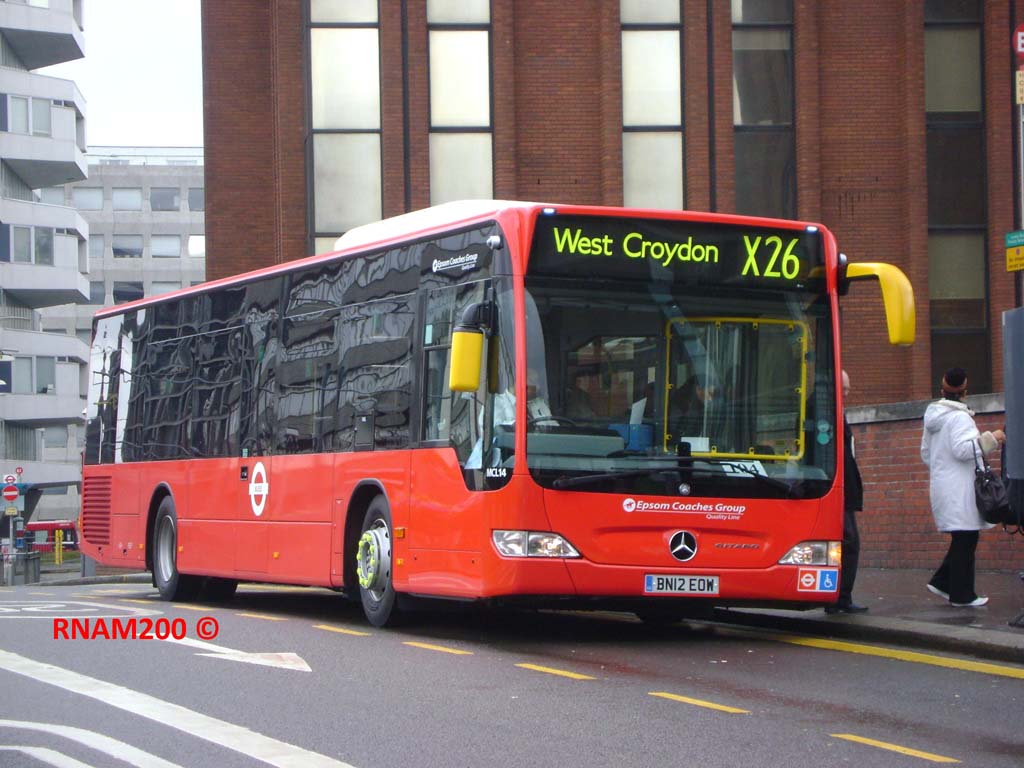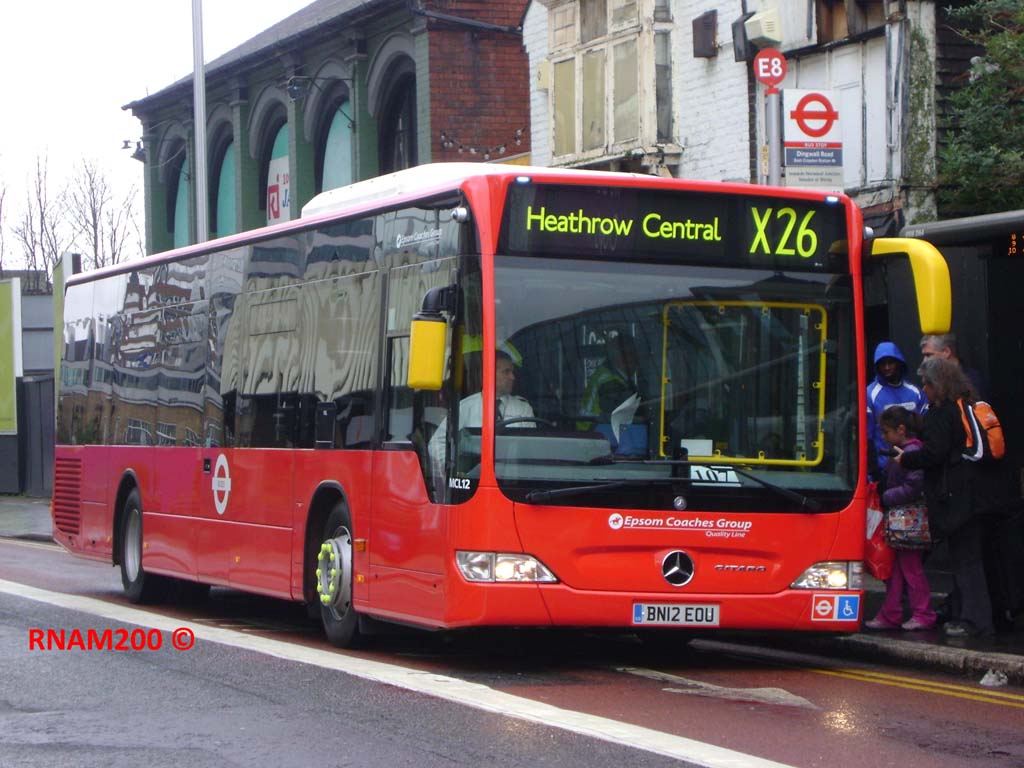 | Photo © RNAM200 (Robert Mighton). |
Home | Bus routes | Operational details | Service changes | Operators & Garages | Photo gallery
The X26 is one of few remnants of the original Green Line network. The alignment through Bromley, Croydon, Sutton and Kingston was first established by route 725, which ran from Gravesend and Dartford through to Staines and Windsor. The 726 was introduced as a probably more useful variant, running from Dartford to Heathrow Airport.
As the Green Line network collapsed, the 726 came under control of London Transport, whose soon-to-be-privatised London Coaches subsidiary operated it from 1992 using DK class DAF/Ikarus dual purpose type vehicles (i.e. coach seating in a bus body). Such was the success of the service that in 1994 a number of extra journeys were added to the basic hourly schedule at busy times, with three extra DKs purchased to service the increased vehicle requirement.
London Coaches originally ran the 726 from their Wandsworth garage, which operates the London sightseeing tour and is now in the hands of Arriva, but operation was moved in two stages to Northfleet, home of the former North Kent Express commuter coach routes. All journeys ran in service with the result that the first bus left Dartford at 0320 with the last bus back to Dartford arriving at 0209 almost a 24 hour service!
But, inexplicably, London Transport seemed determined to get rid of the route, and for a long time a cloud hung over it. The first step in its destruction was when London Coaches, which had been struggling to run the service, gave up, and the route was transferred to Capital Logistics, which operated it from the other end; numerous journeys were deleted from the timetable.
But, amid much protest and a substantial campaign, LT still wanted to axe the service. Eventually a compromise was reached, and early in 1999 the service was cut back to run between Bromley and Heathrow only, and yet more journeys were cut from the timetable, returning the service to regular hourly, and with no early morning or late evening service. The first journey to Heathrow arrived around 0745, two hours after the first plane departures, and after the 0600 shift change at the airport. This journey was invariably packed to the gunwales.
Needless to say, the usefulness of the service east of about Croydon was considerably diminished; what happened to all the passengers whom LT said would be transferring to local buses to complete their journeys to Bexleyheath remains a mystery. On the other hand, the Heathrow end of the route remained very busy, with severe overcrowding at times.
Capital Logistics was bought up by Tellings-Golden Miller (TGM) on 1 June 1999, co-incidentally just after a new contract for the 726 had been awarded to TGM in their own right, for takeup during 2000. The original DAFs, which had transferred from London Coaches, transferred again, although new low floor buses were specified, and 7 ALX300 bodied Volvo B10BLE buses were purchased.
If this all sounds a bit irrational, that's because it is. Nearly everyone who commented said that the service should go up to half hourly all day to make it more attractive; furthermore, the route was retracted from Dartford just two weeks before the huge shopping complex at Bluewater, near Dartford, was opened! It would have been far more forward-thinking to extend the service there, to carry in the crowds from across South London.
As if that wasnt enough meddling, contract renewal in 2005 resulted in further changes. The 726 was renumbered X26, withdrawn between Bromley and East Croydon and had many other intermediate stops withdrawn. From my observations, a substantial proportion of passenger journeys on the 726 either started or finished at one of the stops that was originally proposed for withdrawal, typical usage being people travelling between a stop near their home to Heathrow, Kingston, Croydon or other major stops. With the exception of the more direct routeing possible by omitting Feltham, the logic of withdrawing any of these stops escapes me, and it has had little impact upon journey times, the new timetable quickly having proved just as unachievable as the old one had latterly been, compounded by a substantial reduction in recovery times at each end.
Tellings was said to be quite keen to dump the 726, with punctuality figures as low as 30% being quite common. The award of the route to Metrobus was not therefore a great surprise, although the initial operation from Godstone was hardly ideal. New Scania OmniCities were obtained thankfully not Darts! Interestingly the tender was specified as a double deck route, now possible as it no longer passes under the low bridge at Shortlands. In the event several stops were restored to the specification post award, including a new stop at Teddington the route previously ran via Hampton Court. One quirk of the timetable was that the first journeys in each direction arrived at 07:25 and 07:26 respectively one wonders if the compiler had a little nostalgia for the roots of the X26!
Metrobus, to its credit, did a good deal of work to improve the timetable and make it more robust, which certainly paid off. This was evidently so successful that the route gained a 2-year contract extension, which most people had not thought possible. Garage runs to and from Heathrow were also "livened-up," giving a much more acceptable spread of arrivals and departures at Heathrow. The route also moved to Metrobus's new Croydon garage with the closure of Godstone.
But the big break came after the election of Boris Johnson as Mayor of London in 2008 on a manifesto which included introducing orbital express bus routes. Unfortunately TfL's evident hatred of such a concept seems to have got the better of him and nothing came of it, but the one improvement that did manage to filter through was to the X26, which was doubled in frequency to half hourly; most unusually, Metrobus moved some OmniCities from its "country" operation. What was doubly ironic about this is that most London buses are dual door, but the X26 uses single door buses; whereas most country buses are single door, but these buses were specified with dual doors for the Crawley Fastway network! We could have had the bizarre situation of buses being converted to single door for London work, but the dual doors were retained despite the layout being unsuitable for the purpose.
Given their efforts to transform the service, Metrobus must be somewhat miffed to lose it to Quality Line, which took effect from 14 April 2012. The evening service was increased to half hourly it is not often these days that such improvements occur. New Mercedes Citaro single deckers are used, again single doored.
 | Photo © RNAM200 (Robert Mighton). |
Two views are provided on this page, both on the first day, showing opposite directions and a contrast in street scenery at East Croydon. Buses in both directions take a detour to serve the station; MCL14 (BN12 EOW) is on an arriving journey, which has the more circuitous routeing, pausing opposite the station entrance; while MCL12 (BN12 EOU) is round the corner in Dingwall Road, not perhaps the ideal location for Heathrow bound passengers to have to wait. The massive mirrors are wisely coloured yellow to reduce the chance of accidents; quite why the frame round the drivers' assault screen needs to be similarly visible is not clear! TfL seems unable to make up its mind about the best destination descriptions, "Heathrow Airport" and "Croydon Town Centre" having both been used by Metrobus. The buses were delivered with only a day or two to spare and the iBus equipment was not working on some buses for the first week or two.
 | Photo © RNAM200 (Robert Mighton). |
Navigation
| Previous | Next | |
| Chronologically | W3 | 257 |
| Numerically | W16 | N/A |
Photo Gallery | Bus route list | Operational details | Service changes | Operators & Garages